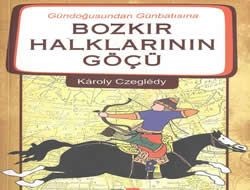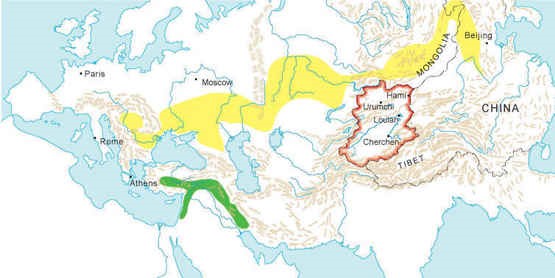The forested region in the north of the Eurasian continent, which offers a fisher, hunter and gatherer lifestyle to its inhabitants, continues to the south with a temporary bush belt; Further south from here, open and grassy steppes stretch from Nagyalföld in Hungary to Mongolia and the Great Wall of China. 1 This steppe belt offers its inhabitants a different and more demanding lifestyle than the forest and bush belt in the north. The changing conditions of the meadows and pastures of the steppe zone in summer and winter forced the peoples to a nomadic lifestyle in order to continue their lives; thus, the fierceness of the struggle for survival made the peoples of this region stronger than the settled peoples and led to the enrichment of their knowledge of the art of living.
The dominance of this steppe belt, which has been the settlement area of both Turkish and Iranian tribes since the first ages, has definitely passed into the hands of the Turkish tribes with the Hun raids in AD 370. 2 As far as history knows, the Turkish tribes were not only the sole rulers of the steppe belt, but also the agricultural belt, which included China, North India and the Middle East. Therefore, it is a fact that Turkish tribes have lived in the southern agricultural belt of the steppe since the dark ages of prehistory. This is clearly demonstrated by the language data we have. Mainly barley, wheat, vetch, etc. Many plant names and agricultural words such as ank, plow, s({-bClll, etc.) were taken from Turkish in many of the neighboring languages.
When we take a look at the words related to the food and clothing culture that Turkish has given to neighboring languages, we can see that the names of animal products such as meat and milk, which play a fundamental role in the nutrition of the people of the steppe generation, and the names of clothing based on wool and leather, which are the raw material of clothing, are also used in the nutrition of the people of the agricultural generation. We see that the names of plants that play a fundamental role and the names of clothes based on cotton and cloth, which are the raw materials of clothing, are given to these languages and taught to neighbors. The fact that Turkish has presented its neighbors with the names of food based on agriculture and grain on the one hand, and clothing based on cotton and cloth on the other, shows that the agricultural belt is the settlement area of Turks as well as the steppe belt.
XIII. Since the texts up to the 19th century, apart from Divanü Lugat-it Türk and a few small texts, are full of the concepts of history, state administration, religion, goodness and evil, lamentation and love, and therefore belong to the areas far above the lower layers of a culture such as clothing and nutrition, They do not carry detailed information about the daily life of these periods.
Clothing is largely related to geography, both in the past and today. Nutrition has been an important measure in the descriptions of cultures, as it is related to economic life as much as geography. 3 While the main food source of Asia and the Middle East south of the steppe was cereal and bread, the main source of nutrition for steppe peoples was milk and dairy products.
Meals obtained from milk by Mongolian tribes based on dairy products, which they call white food and hClrcı idegen: black food, which emerged on the stage of history of the steppe long after the Turkish and Iranian tribes, are also quite abundant: sü(n): milk; milk / milk: dessert made by adding milk; subsu/ ayrag : fermented milk of kumiss, mare or cow; arakı(n): drink made from ayran; tile / cluster: diluted boiled milk; tarag : sour milk; cag-a : boiled tarag; horuca: triple distilled hard milk cognac; bocu: sediment, precipitate; cige(n) / cege(n) : kumiss obtained from mare’s milk; şar tos/ çöçgiyn tos: butter, etc.4
As we said, XIII. While our language heirlooms before the 19th century do not have much nutritional material, as they belong to the upper cultural areas, the number of words related to dairy products in Divanü Lugat-it Türk reaches nineteen, thirteen being nouns and six verbs: milk: milk; ski / kanak: ski; igduk: milk food; yarn : milk drink; I found: Höşmerim prepared by adding fresh or raisins; right fat : butter; udtma : fresh and fresh cheese; cottage : skim and dry cheese; Kurut / sugut: cottage cheese, cheese made from skimmed yoghurt; ayran : churned milk; yoghurt : yoghurt; kumis: beverage obtained by fermenting mare’s milk; ember: beverage obtained by fermenting curdled milk; korlan- / bagullan- / put- / udış- / biş-: to leaven, to darken, to concentrate. 5
In the Scan Dictionary of Turkey Turkish, which is mostly obtained by scanning the literary works, there are only the words siit, milky ash, mouth / angız / milk mouth, ayran kurusu, kurut, kökk / cokelek, dorak / torak, and the words yoghurt and ayran. Not even a place is given.6
In the Turkish Dictionary, which is prepared by consulting the works of the twentieth century scribes of Turkey Turkish and which is the writing DJj dictionary of today’s Turkey Turkish, only the words ayran, cottage cheese, höşmerin, katik, kayırak, cut / curd, kurut, curd, cheese, milk and yoghurt are included. ,7
On this path from the old Turkish written language to the written language of the Turks of Turkey, the fact that we have forgotten many dairy products and therefore their names, 4 Lessing, Ferdinand D., Mongoliwi – English Dictionary, Bloomington 1973.
5 Dankoff Robert – Kelly James, Mahmud al-Kasgari, Dictionary of Turkish Dialects, Harvard 1985.
6 Screening Dictionary, TDK Pub., Ankara 1963-1977.
7 Turkish Dictionary I-IL, TDK Yay., Ankara 1988.
J 70 On Turkish Sayings About Dairy Products
it can easily be interpreted as the settled life pushing the animal into the background next to the plant and thus changing the feeding tradition; but as it is known, the Compilation Dictionary, which consists of the words of Turkey Turkish other than the written language, contains the names of food and beverage made with milk and dairy products over a hundred. 8 Although the Compilation Dictionary contains quite a few words about dairy products, when we look at the richness of other Turkish dialects living in the steppe and the abundance of words Turkish gives to Russian, Hungarian, Persian and various Balkan languages, it is clear that most of the names of these products, like the tradition of feeding with dairy products, are in the steppe. It is clear that we left.
Prof Dr Gunay Karaagac
http://dergipark.ulakbim.gov.tr/tdded/article/viewFile/5000132759/5000121608
Migration of Steppe Peoples from the Sun-East to the Sun-West (Karoly Czegledy)

Migration of Steppe Peoples from the Sun-East to the Sun-West (Karoly Czegledy)
| Category | : Prof.Dr.Günay KARAAĞAÇ |
| Comment | : 0 |
| Read | : 2290 |
Share |
Migration of steppe peoples, BC. II. – AD VI. It deals with the migrations of people to the west and south from the steppe belt stretching from the Polish steppes to the Great Wall of China between the centuries. The investigation of these events, which were mentioned in a legendary language until the 18th century, was established in the last quarter of the 19th century, especially when the runic Turkish inscriptions were resolved in the last quarter of the 19th century. Let’s listen to these events that took place from sunrise to sunset from the pen of Karoly Czegledy, one of the most important knowers of the subject.



















